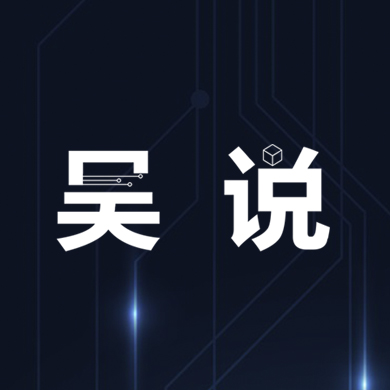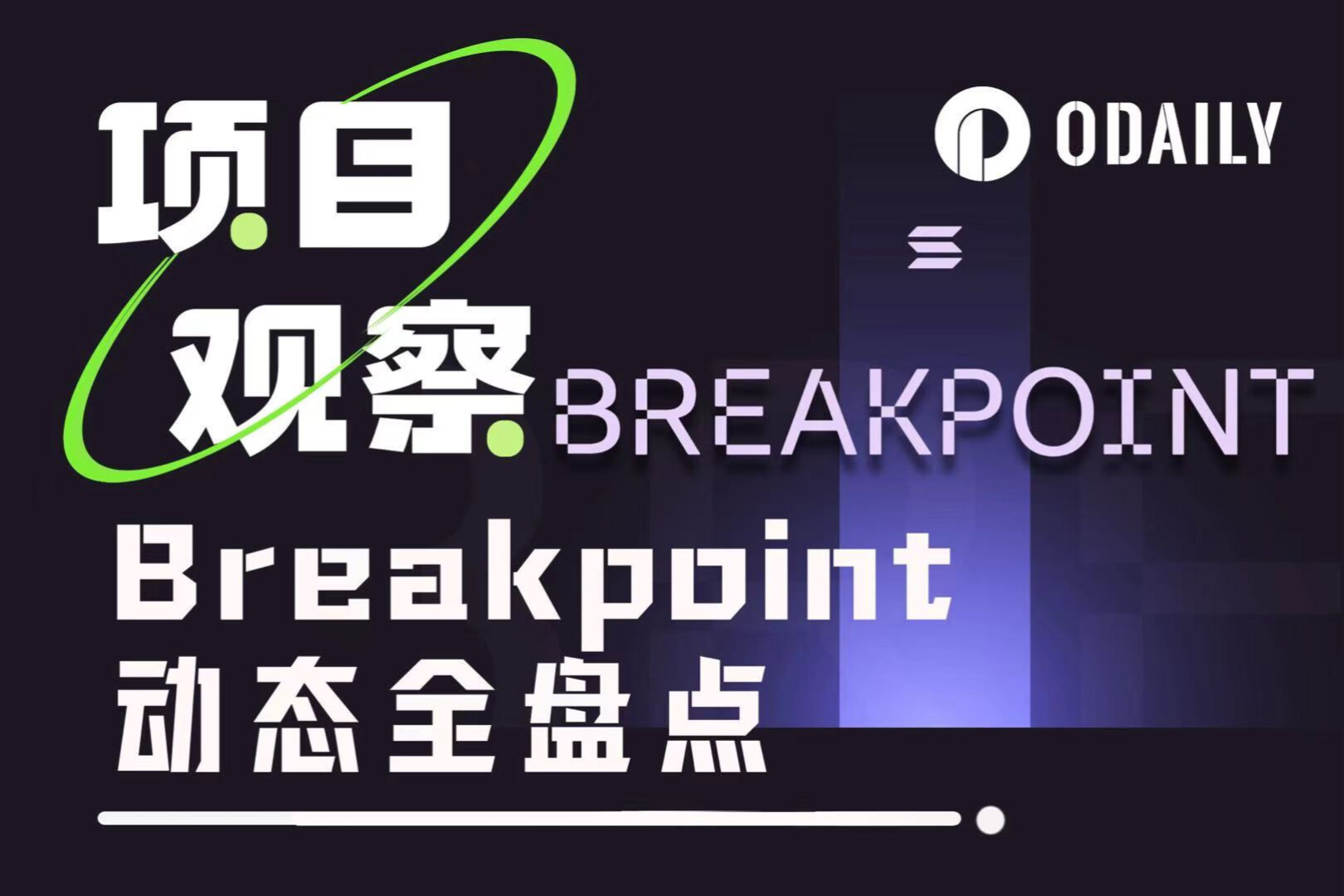Pantera Capital: Ethereum tightens more than Fed
first level title
Original compilation: Wu said blockchain
The Fed hasn't tightened much
The Fed hasn't really tightened monetary policy yet. Inflation has risen far more than the federal funds rate over the past few years. Just as importantly, the Fed has not given up on manipulating the government bond and mortgage markets.
Real interest rates, the rate investors get after deducting inflation compensation, are near their lowest levels ever.
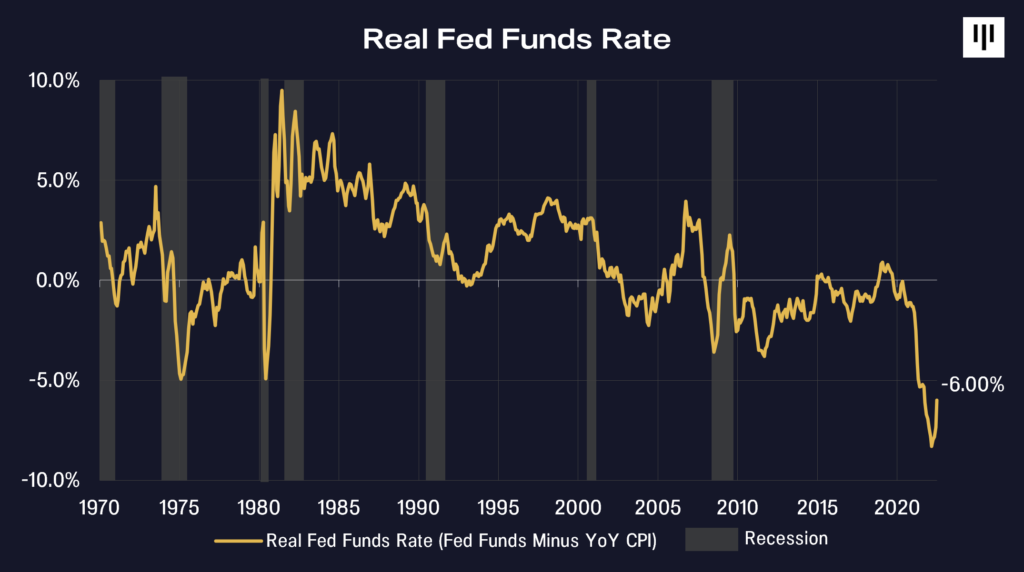
More on this later, but one thing is clear: Runaway inflation cannot be tamed with a fed funds rate 6% below inflation. The Fed will be forced to tighten much more than the market is currently predicting.
A little over a year ago, the real federal funds rate broke its previous negative record set in February 1975. In the 70's we had a little bit higher year-over-year inflation at about 11.2%, but the Fed was trying to fight inflation with a fed funds rate of 6.24%. Therefore, the federal funds effective rate is -4.96%.
The Fed passed this milestone with flying colors. Until it fell to -8.30% in March 2022, the Fed finally began to unwind its large-scale easing policy. When the tightening of monetary policy started, the CPI was already at an incredible 8.5% year-on-year
As the table below shows, the real federal funds rate is still 7.77% below the average rate over the past 50 years. Adding 75 bps doesn't help either. The Fed will eventually have to tighten another few hundred basis points.
I still believe that rate hikes won't stop until the fed funds rate is at least 4-5%.
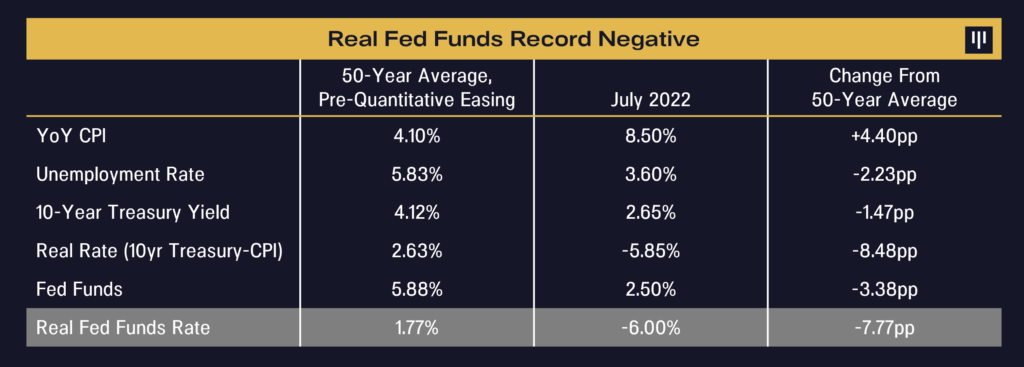
I like this passage:
"The whole point of raising rates by 75 basis points is to tighten financial conditions. The irony is that whenever Jay Powell raises rates, he eases financial conditions because he doesn't want to admit that the Fed is prepared to Bring the country into recession."
first level title
Real bond interest rates are also severely negative
While the consensus now is that the Fed's allowing inflation to run 830 basis points above its overnight policy rate was a colossal failure, few have addressed an equally important and ongoing policy mistake: keeping long-term government bond and mortgage bond yields in check. at levels far below the free market.
As Bill Ackman stated, the Fed chair will not allow long-term interest rates to adjust to fair market levels (much higher). As a result, the Fed is still massively stimulating interest-rate-sensitive sectors such as housing and motor vehicles.
The real rate of return is the bond yield investors receive after inflation. For US 10-year Treasuries, the five-year average real rate prior to quantitative easing (1957-2007) was +2.63%.
The Fed decided to print half of the country's GDP to drive up bond prices and force real interest rates down to -5.85%.
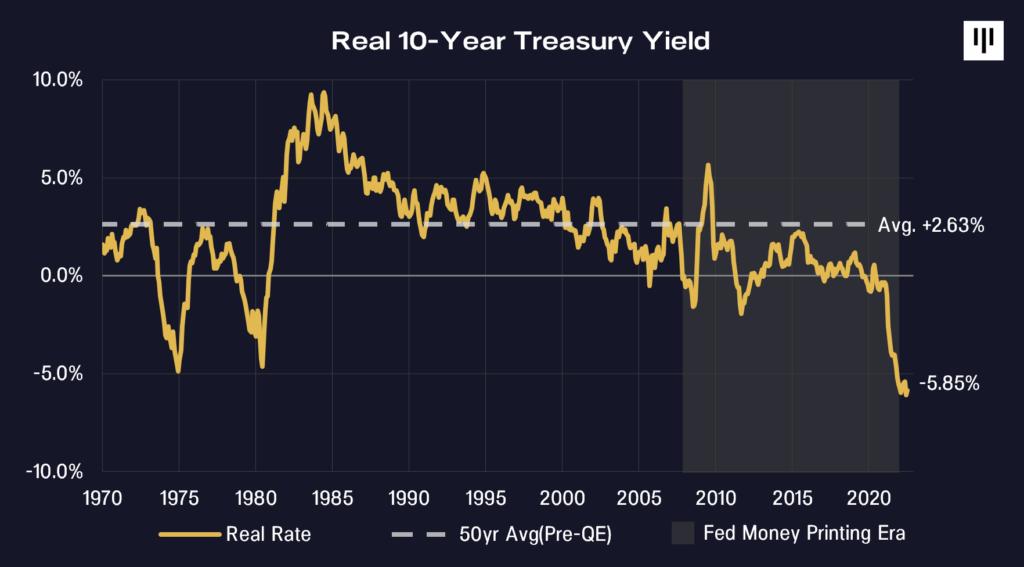
The gray area, our new world of unlimited bond buying, is at an incredible low of 8.48 percentage points below average.
first level title
taylor rule
Economist John Taylor's rules-based target for nominal interest rates is 6.92%, about double current expectations, according to a June Fed report.
I think robots know more than humans.
The ratio will eventually be closer to the Taylor rule than currently predicted.
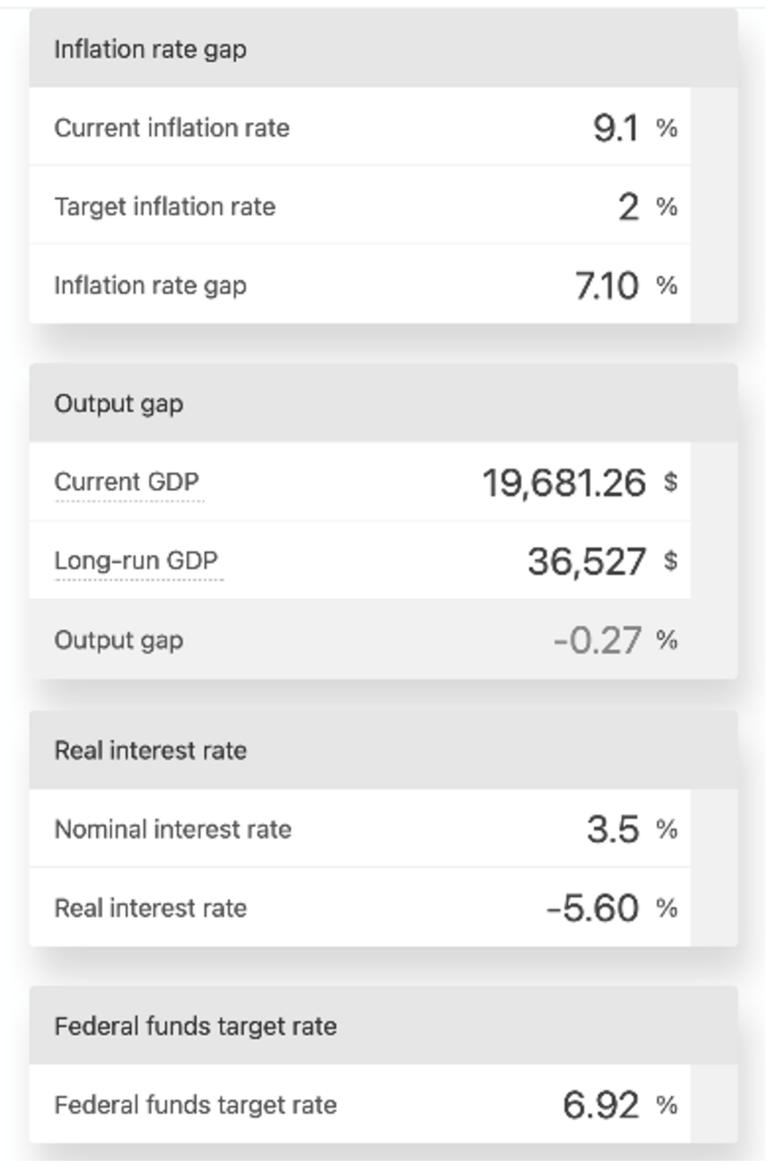
"The Taylor rule is a targeted monetary policy used by central banks. American economist John B. Taylor was the author of Gerald Ford and George H.W. Bush's George HW Bush, an economic adviser to the administration of President George HW Bush, proposed the rule in 1992 as a means for central banks to stabilize economic activity by setting interest rates.
"The rule is based on changes in three main indicators: the federal funds rate, the price level, and real income. The Taylor rule holds that keeping the real short-term rate steady and the neutral policy stance should be met when the output gap is positive and the inflation gap exceeds the target Raise interest rates.
"According to Taylor, a central bank implements a stable monetary policy when it raises nominal interest rates by more than the level at which inflation rises. In other words, the Taylor rule states that when actual inflation is above target, interest rates Relatively high. The advantage of the general objective rule is that the central bank can obtain discretion to use a variety of means to achieve the stated objective.
first level title
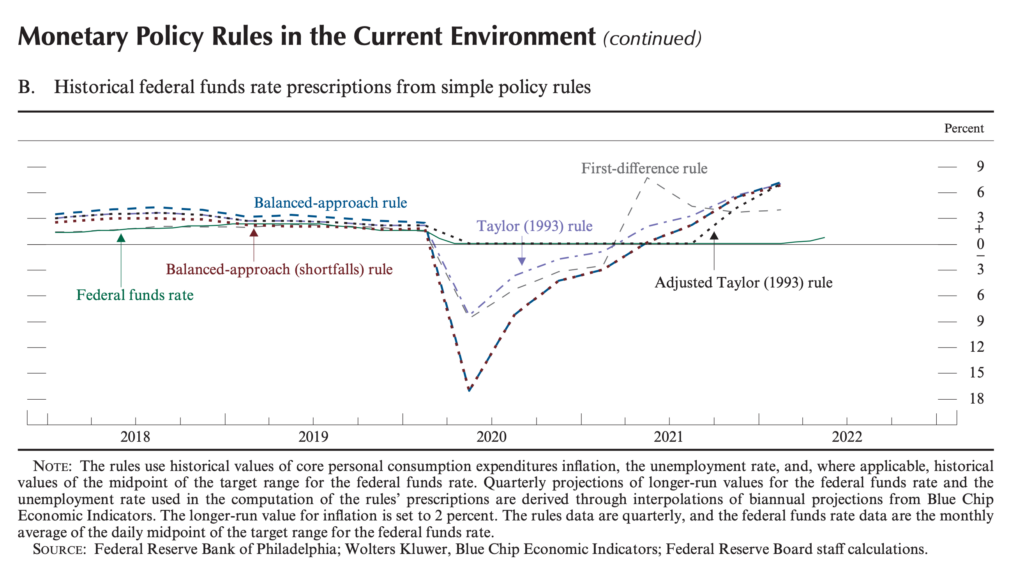
An overview of the recession
Surprisingly, economists still see only a 45% chance of a recession. But economists are notoriously lagging in forecasting recessions, missing negative growth in the first and second quarters of the year.
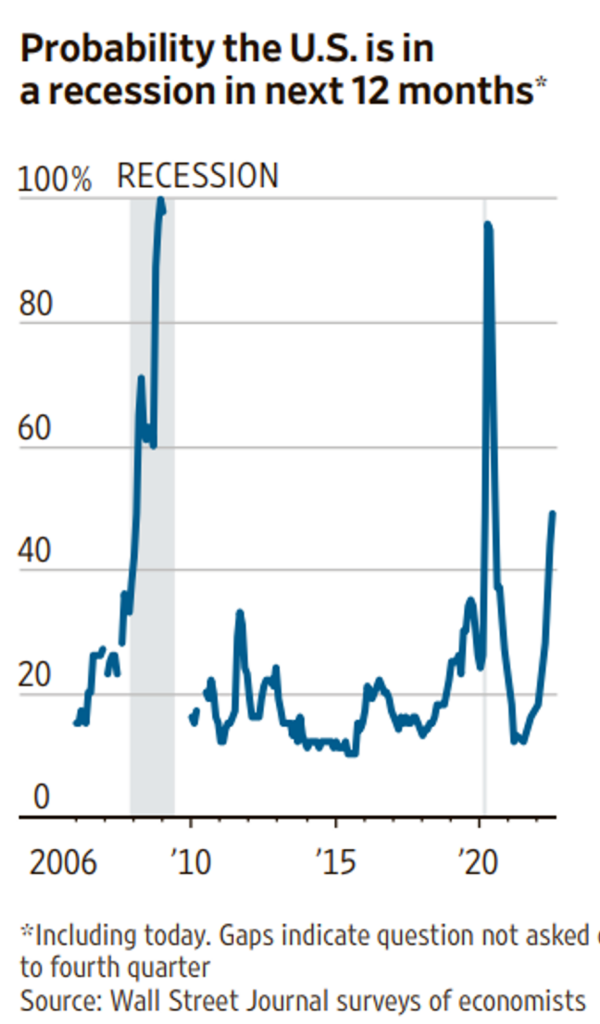
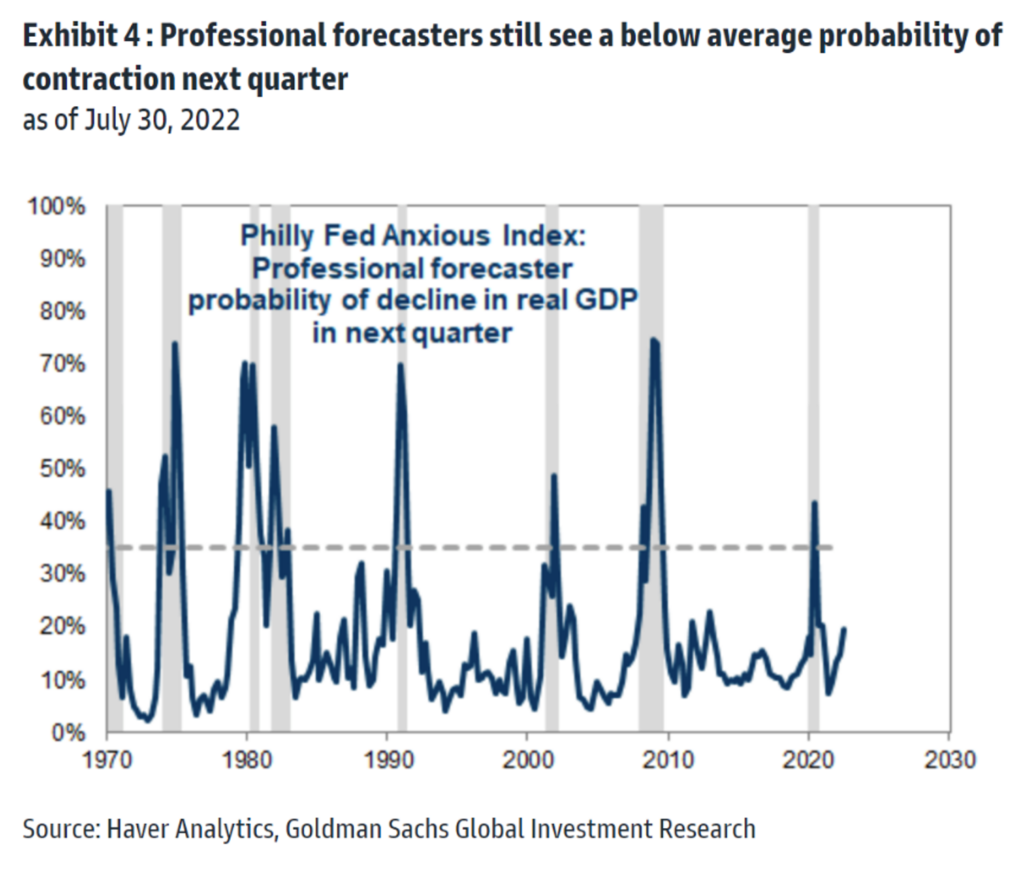
first level title
The recession has almost certainly begun
We have had two consecutive quarters of negative GDP growth, -1.6% in the first quarter of 2022 and -0.9% in the second quarter. While this is not the defining criterion of the BEA, it is a strong indication that we are now in a recession. Unfortunately, the Fed's policy mandate is not to "keep tightening until it triggers a recession." The Fed's goal is to boost employment and stabilize prices, which will require more tightening.
As we mentioned last month, we are likely already in a recession.
Federal Open Market Committee (FOMC)
Larry Summers was right all along. The Fed won't stop tightening until inflation is back at 2% (which is effectively out of control), so a recession is basically a given.
"If it looks like the economy is slowing, it would be tempting to stop raising rates, and indeed, people in the market are expecting rates to come down from December or January. I think that would be a serious mistake."
"I don't think we're all likely to get inflation back to target without a recession."
– Larry Summers, Former Treasury Secretary, August 3, 2022
first level title
The promise of blockchain technology
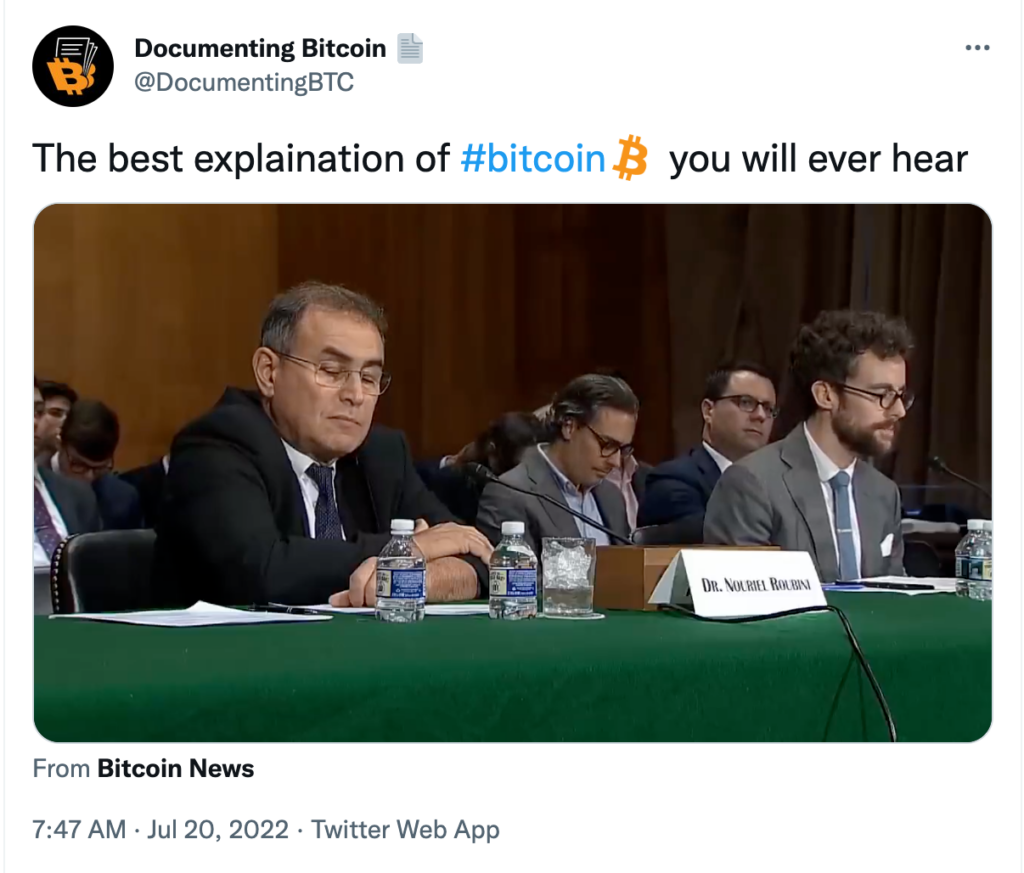
We highly recommend that you take six minutes to watch this segment. This is a clear and simple explanation of the importance of our industry. Here are the highlights from the video:
"What does Bitcoin do? It's very simple. It allows you to use a computer and the Internet to connect the world, send and receive money to anyone in the world. So, why is it revolutionary? Because unlike all other ways of sending money over the Internet Tools are different, it works without trusting a middleman. There are no companies in between, which means that Bitcoin is the world's first public digital payment infrastructure. About being public, I'm just saying that everyone can use it, not Owned by any single entity."
"The Bitcoin network is a public blockchain, and anyone can add an entry to that ledger to transfer their bitcoins to anyone else, regardless of nationality, race, religion, gender, sexuality, or reputation. Create a Bitcoin address for free to receive payments digitally. Bitcoin is the world's first globally accessible public currency."
"This is a breakthrough in computer science that will be as important to freedom and human prosperity as the birth of the Internet."
"The Internet eliminated the single point of failure of communications infrastructure and ushered in a wave of competition among new media companies above its common rails."
"...it is our best hope that, like the Internet in the 1990s, we need a moderate pro-innovation policy to ensure that these innovations flourish in the United States for the benefit and safety of all Americans. "
first level title
Ethereum merger related
Ethereum will soon undergo its most significant update since launch. The "merge" is one in a series of protocol updates in the ethereum roadmap, marking a huge step forward in the long-term sustainability and scalability of the global computing network.
The key takeaways are:
1. Full migration from Proof of Work (PoW) to Proof of Stake (PoS) → Ethereum becomes more sustainable
2. The issuance rate of Ethereum is reduced by 90% → Ethereum is likely to become a deflationary asset
first level title
Ethereum becomes more sustainable
Moving to proof-of-stake will have a significant impact on the sustainability of Ethereum, with an estimated 99.95% reduction in energy consumption. From an environmental, social and governance (ESG) perspective, this is clearly a big improvement.
Proof-of-work and proof-of-stake are consensus mechanisms that enable a network of computers to agree on its current state. In this case, a network of computers work together to secure and maintain the blockchain (which is really just a database of transactions). In short, consensus mechanisms enable blockchains to operate securely in a distributed fashion.
99.95% of the energy reduction will come from Ethereum's transition from PoW, a process of securing the network where the main costs are electricity and hardware. In a PoS system, the main cost of securing the network is capital in the form of staked tokens, and that doesn't require much electricity at all.
Both have the same goal of achieving distributed consensus while making it extremely difficult for a single entity to gain control of the network (i.e. a 51% attack). The latter is ensured by controlling for physical or economic infeasibility.
In Bitcoin under PoW, someone has to buy enough hardware and electricity to achieve more than 50% of the network's hashing power.
In Ethereum under PoS, someone must accumulate more than 50% of the total staked tokens in the network.
Both scenarios are capital intensive and would cost the attacker more than they gain, so are unlikely to happen.
first level title
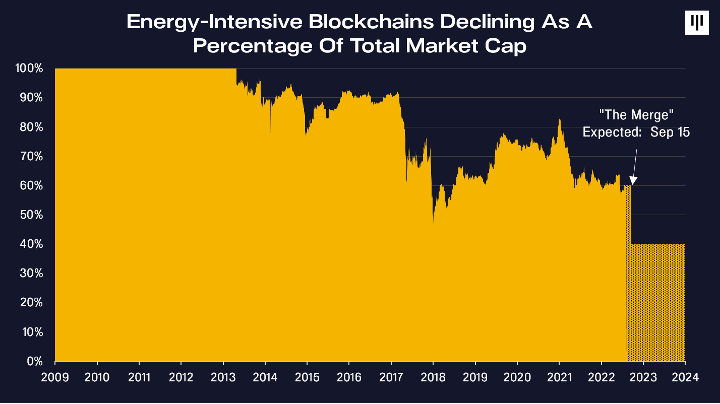
Ethereum Supply Could Be Deflationary
If you're wondering why the event is called a "merge", it refers to the "merge" of the Ethereum mainnet (execution layer) with the Beacon Chain (consensus layer), which has been running in parallel since December 2020. Ethereum, which facilitates our DeFi transactions today, is the execution layer, which runs on proof-of-work. The Beacon Chain consensus layer utilizes Proof of Stake. The merger of the two is when Ethereum transitions to proof-of-stake. So, what does this have to do with distribution and supply?
Currently, Ethereum’s new issuance is about 14undefined600 ETH/day, which is the sum of 13undefined000 ETH from mining rewards on the mainnet and 1undefined600 ETH from staking rewards on the beacon chain. After the "merge", there will be no proof-of-work, and therefore no mining rewards, leaving only 1undefined600 ETH daily staking rewards.
A year ago, the London upgrade went live, introducing a minimum fee (known as a base fee) for each transaction to be considered valid. According to the ethereum website, the fee is then burned, removing approximately 1undefined600 ETH from the total daily supply based on an average gas price of 16 gwei. (A gwei is one billionth of an ETH.)
first level title
secondary title
past few months
Ryan Sean Adams: Can you tell us what happened in the last three months?
Dan:“We’ve had secular bull markets in everything: interest rates, stocks, cryptocurrencies. In bull markets, people use more and more leverage.”
"In the crypto industry, most lending companies started in 2017. They enjoyed the market's rise during this period, after all, Bitcoin was only a few thousand dollars smaller. Some people over-leveraged, when the market fell 80%. Really dangerous."
“I think everyone should have the point that anytime you have a super disruptive technology, people are going to try all kinds of business models. It’s like the internet in the 90s, some work, some don’t, some are great. Fortunately, some people are not so lucky. But in the end, because the underlying technology is so good, blockchain will be critical.”
Joey:"I remember when I first joined Pantera, Dan said 'pool products tend to be limited by the least liquid asset'. Lenders started letting people borrow against what they thought was close to one-to-one collateral, But that’s not the case from a liquidity standpoint.”
“If you look at GBTC, there are two liquidity issues there. It takes six months to sell after buying. Some companies will let you borrow in cash at very high loan-to-value ratios, even if the underlying asset can’t be sold at all. Even if it is Liquid, GBTC is not volume matched to Bitcoin either. GBTC is a much less liquid asset and it is traded in the over-the-counter market.”
secondary title
Defi vs. Wall Street
Ryan: What do you think of the criticism that “DeFi is the same as Wall Street”?
Joey:"They're completely different in some very key ways. Historically, on Wall Street, there hasn't been a lot of transparency about what's actually going on. In 2008, nobody (not even people at these firms) knew that their derivatives How much is the exposure. When a bailout is needed, governments are both guessing how much they need to spend to actually bail out, and they don't know the exposure to derivatives until long after everything has happened. In traditional finance, because things are opaque , you don’t actually know what’s going on, you don’t know what your actual risk is, and you get all these weird situations in traditional finance.”
“CeFi companies built on top of DeFi, like Celsius, have the same problem. If Celsius showed the ins and outs of every dollar deposited into Celsius on their website, I don’t think we would be talking about Celsius today because they There will be no clients. What will clients do if they know they will have to wait two years to withdraw all their funds and that their money is invested in assets that could go to zero (implying LUNA)?"
Dan:“Transparency is at the heart of blockchain. DeFi projects all allow you to see what’s going on. However, as Joey said, if you really know what’s going on behind these centralized lenders, you may never Lend them any money."
“The Lehman story is very interesting because when it failed, no one knew what risk their actions put the company at, and no one knew what collateral they had. Everyone took what they could. The voided contract didn't return the collateral. It was all just a mess. At the beginning, people were like, '$120 billion lost, this is all bad, the world is going to end. By the time the bankruptcy process ends six years later, they've lost $39 Billion dollars. That's insignificant compared to the insane damage it's doing to the entire world. It would be better for the US Treasury to write a check for $3.9 billion ahead of time. That's insane. Because no one knows, a complete black box."
“That’s the beauty of DeFi. The protocol will have all the information and you can make a choice. For example, do you want to start a business on MakerDao? You can look at all the statistics and decide whether it’s a good idea or not.”
"Take Mt. Gox as an example, it's a failed CeFi project. We're still dealing with bankruptcy. Seven years ago and it's still going on. And in DeFi, we're done. We've gone through the May crisis , it’s over and we’re on to the next thing. Not a single taxpayer pays a dime.”
“The next generation of centralized lenders will be forced to provide more transparency. We did a five-year experiment in the whole black box and it didn’t work out very well. Whether it’s commercially motivated or regulators (probably both) No one would want to lend billions of dollars to entities that don’t know what they’re doing.”
"We've even seen that with Credit Suisse and other large family office lenders, they don't know how much leverage their clients are taking."
“Everyone is learning this lesson, both in the crypto space and in the normal securities market. They will be forced to disclose more about how much leverage they have, and the imbalance between their liability time frame and assets. Regulatory Institutions may become more active and demand greater transparency."
Joey:"Second is risk control. There's a good saying in software, 'worse is better'. I think you can think of that in risk control systems. On Wall Street, people come up with these very complex risk control mechanisms, And convincing themselves that they know better than everyone else and that their risk mechanism is correct. You saw this in 2008 with the credit default swap issue. If you look at the financial history of the last 300 years, whether it's long-term capital management Whether it's Three Arrows or whoever, you'll see it many times."
secondary title
Criticism of DeFi being too self-referential
Ryan: “DeFi is too self-referential. There are no real world assets, and even if you stake something, it’s another DeFi token. What do you think of this comment?”
Joey:“If you look at the history of innovation in financial technology, people use this criticism every time. Whether it’s the invention of the joint stock company hundreds of years ago, or the invention of options, swaps, every derivative, how people criticize it. Interestingly, it's both right and wrong. In the beginning, new technologies were heavily speculative. They were very self-referential. When the Internet first came out, it was a bunch of academics sending papers to each other for peer review. Pretty self-referential."
"But over time, people discover new use cases for these technologies. They figure out new ways to use them in the real world. You fast forward 5-10 years, and no one is making that criticism anymore. Or at least , those who make this kind of criticism, no one cares, because obviously, they are wrong. Imagine saying that the Internet is only self-referential today, which is meaningless. Many people said that in the 90s. You can find a lot of The video of the talk show where the host makes fun of Bill Gates saying, 'What is this crazy thing you call the Internet? Seems like a bit of a joke. The same goes for the history of cars,' Well, my horse is faster, So I don't need that car. People are very short-sighted when it comes to technological innovation."
“That’s true today, but it’s starting to change. It’s harder to do things in the real world than it is in the virtual world, but I think we’re starting to see more of that. Derivatives, it's probably starting to take off more -- Synthetics, for example, have had a bunch of new traction lately. Then, there's been some stuff going on in the real world at Maker Dao. It's very raw and early, but I think If we had this conversation again in five years, it wouldn't look raw and early."
Dan:secondary title
Defi works smoothly
Ryan: How well is DeFi doing in this storm?
Joey:“If you look at the difference in DeFi, the main thing is how it works, it’s just much faster on the liquidator side. Compared to CeFi companies, DeFi has a simple liquidation mechanism. The CeFi mechanism doesn’t work that way Yes. I have friends who have used these firms and I know that when they are close to liquidation, they usually give them 24~48 hours to replenish their liquidity. Even if they have fallen below face value, because they just trust them as a counterparty .There is a lot of risk in doing that. In DeFi, you really don’t have that problem.”
Dan:secondary title
macro express
Dan:“My main view for the next 12 months is that crypto will decouple from the macro story and trade on its own fundamentals. There will be a lot of people using crypto products, DeFi will be business as usual, etc.
"On the macro side, I think the Fed is going to have to raise rates a lot more than people talk about. The Fed's mandate is to raise rates until core CPI is below 2%. It's going to take a few years, and things will go on forever .
“So in general, I think interest rates will continue to rise, and so will cryptocurrencies.
Joey:what we expect
DeFi: A lot of interesting things are happening in DeFi. We are finally starting to see DeFi numbers like TVL starting to trend back up. The total market capitalization of DeFi is about $20 billion. The crypto market cap is one trillion. I think it's ridiculous that DeFi's market cap is less than 10%. I would actually argue that it is much higher than that, 20/30% of the entire crypto market. Therefore, we are very bullish on DeFi in the long run.
first level title
Real Vison Interview Highlights
Raoul Pal: How do you see the up and down risk reward here?
Dan:“The best time to buy is when people are predicting how the next halving is going to happen. At $65,000 in bitcoin, that worked out pretty well. No one said that, instead, everyone was very bullish at that point.”
“Right now we’re at $20,000 and people think there’s another 50% down. It’s the perfect time to buy, and when everyone’s a bear market expert, it’s a good sign that it’s time. "
"Plus, time itself heals a lot of wounds, right? No matter how leveraged people are, it's been eight months since we were at our highest level. Those things have been sorted out in that time. We've been well over The average length of a bear market, or the same depth. We've been down for eight months."
Raoul Pal: Are you buying the bottom line, or are you waiting and watching?
Dan:"Massive public pension plans, endowments, etc. are coming in. It's actually been a good time because they've spent four to five years, through all the hard work, their investment committees, educating their fiduciaries People wait. They're finally unified, and they're much cheaper now."
"We haven't seen enough 'motivation' because most investors are really sorting their portfolios. It's a once-in-a-lifetime shock to macro markets and blockchain. Everyone's holding back, and Trying to make sure they understand the liquidity situation etc."
“But I do think we’re in a really good place, a lot of institutions have really been approved recently. In many cases, they’ve allocated 10 basis points of funding for the blockchain space. They’re managing $100 billion or thousands $100 million in funding, that means $100 million in the blockchain space. Over the years, I've seen commodities become an asset class, along with emerging markets, etc. I can easily see blockchain in Five years from now it will be an asset class."
"10 bps isn't the end goal, right? It's got to be 500-800 bps, or more. That's another reason why I'm very bullish on this space: I see a lot of large entities going through real difficulty going from zero to one thing. Now that they’ve come in and allocated 10 basis points, they can easily get to 20 basis points, or 50 basis points, or 100 basis points, or 500 basis points.”
Raoul Pal: Which tracks are you looking at?
Dan:"DeFi is so cheap right now - I think DeFi should be a big part of what people invest in."
"The next frontier is blockchain games, NFTs and stuff like that. Now they're just reaching critical mass because enough people are using them."
"But for everyone who's trying to have something in your portfolio, it's important not to go too all-in on any one."
Raoul: NFT is a very good technology. what do you think?
Dan:"It's a whole new art form. It's really easy to make fun of NFTs: You pay millions for a piece of software code? 100 years ago, Marcel Duchamp on a wall in Paris A urinal was put in and it’s now worth $150 million.”
"Art is about concepts and community. Every generation has its own art (Wall Street has a bunch of graffiti artists). In 10 or 20 years, they're going to be a very important piece of art."
"One of the reasons people like art is that it's fun, right? It's community, it's sharing. I talked to a very, very successful businessman who is also well-known in the art world and he's very negative on NFTs. Probably There are some collectors who actually buy art because they like art and they put it in a warehouse in Geneva and no one sees it. Most people buy art to put it on their living room wall, Show their friends, right?"
"How many people can walk through your living room? Even if you're really socialist, not that many. You can have a lot of people view your NFT collection. It's much easier to share. I think it will put a lot of Bringing people into the blockchain space. NFT is very important, and many people have not really paid attention to it.”
“These things take decades; it won’t happen overnight. Gen Z who buy NFTs will be 50/60 rich in 30 years. They probably won’t buy a Renaissance painting ,Right?"
"A new generation can choose who wins, and there is a very tech-literate group that is growing with NFTs."
Raoul Pal: What's the silliest mistake you've made investing in cryptocurrencies?
Dan:"Honestly, a sell. There are a lot of things I wish I bought or regret not doing, but the only deep regret is a sell."
“If people have the financial and emotional resources to stay in this industry, you have to because blockchain is going to change the world, which means the price will be much higher in the long run.”
Original link

